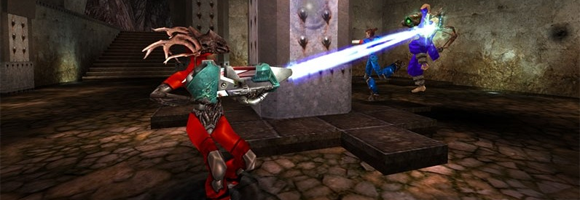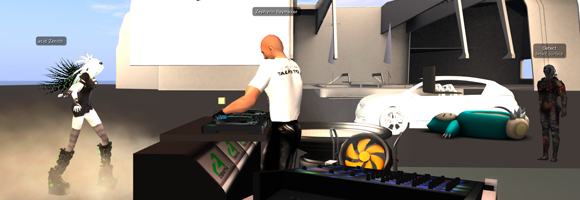
The best comment I read on this was the wonderfully ironic: ” … and you thought it was made of Lego.” Having recovered from that realization, here’s the next hit: This is a picture of ↑Two Story with Basement, ↑Mike Doyle‘s first Lego creation (not counting what he did as a kid). Meanwhile he has added two more projects to his abandoned homes series: ↑Victorian with Tree and ↑Victorian on Mud. More at Mike’s blog ↑snap (including very insightful essays) and at ↑his MOCpages page.
Especially interesting for anthropologists: Mike does not cease to emphasize that his creations wouldn’t have been possible without the vast Lego online community or scene. Support from there comes at least on two levels. On a psychological level, sharing enthusiasm and cheering on. On a hands-on technical level by sharing techniques and solutions to particular building problems.
anthropology meets technology
The BBC carries a short piece by ↑Genevieve Bell, corporate anthropologist at Intel, on what a corporate anthropologist does: ↑Viewpoint: Anthropology meets technology. And ↑anthropologies has the essay ↑Anthropology in High Tech by John Sherry, yet another anthropologist at Intel.
far village

Over at the ↑Ethno::log the issue of the ↑Dogon in particular and Africa in general—respectively how they are represented by the traditional mass media—recently has crept up three times in short sequence. First the entry ↑Afrika by mawingu triggered some discussion. Three days later an ↑entry on ↑an article in the Neue Zürcher Zeitung again triggered a discussion, mainly circling around the topic of stereotypes used in representing Africa, the Dogon in particular here. Finally yesterday ↑the Dogon returned because of ↑an article on them in Die Zeit.
To the wider public the Dogon mainly are renowned for their architecture. The above picture was taken by ↑Dario Menasce—a particle physicist, working at CERN.
In one of the mentioned discussions KerLeone says that he can’t judge certain facts, because he never has been there. Which is a downright lie. I positively know that you have been in a Dogon village. In the very same one I have been. Here’s a snapshot I have taken during my recent visit (only some weeks ago) to said village:

lennart green
After having watched ↵Marco Tempest‘s performance at TED, I discovered, that ↑Lennart Green had performed there, too. It may well have been the same convention, twenty-odd years ago, at which I saw both, Marco Tempest and Lennart Green, live for the first time. No digital electronics or any other high-tech—except a laser beam—in his act. It’s clean and classic, absolute top-notch, highest astonishment and entertainment value, plus downright hilarious. Lennart Green is one of the world-class card magicians alive—my friend ↑Denis Behr, who belongs to the same league and on whom a post here is way overdue as well, says so, too. You won’t regret a single minute of that half hour above.
By the way, Denis will perform ↑live tomorrow evening in Munich.
parts

Here we are! Princes of the universe!
↵They‘re here since some days already, but I didn’t yet come around to celebrate them as they deserve it. This is because I’m a bit knocked down by some nasty infection in the throat—but meanwhile I’m comfortably high on a cocktail of medication. The most parts of it I can’t pronounce, let alone spell correctly. Healers’ magic.
Anyway. Here’s what you can see above, still undead in its coffins.
Motherboard: Asus Sabertooth P67 | CPU: Intel Core i5-2400 | Memory: Corsair Vengeance 16GB | Graphics Cards: 2x Asus HD 6950 2GB (Crossfire)
The rationale behind this assemble goes like that: Teamed in a Crossfire-rig the two HD 6950s in many respects ↑outperform high-end cards working alone, and both twins together still are way cheaper than a HD 6990 or a GTX 590.
With the CPU it’s a ↑similar story. The absolute top of the heap, the i7-2600K, is ridiculously overpriced. Next in line would be the i5-2500K, but “[f]rom the standpoint of raw compute power, Core i5-2500K offers very little over the cheaper Core i5-2400.” Quite obviously (see above) I don’t need the Intel graphics that come with the 2500K. The overclocking feature I won’t have time to play around with, so the 2400 it is.
The Sabertooth I took, because it’s the board of choice in many reference and testing systems.
And the Corsair Vengeance memory? Well, it’s blue.
Now I’m praying that my 700W supply of divine spark will suffice to bring it all to life.
scrolls duel

The patent portfolio battles between Apple on the one side and Samsung, Google, and whomyouhave on the other sides, are all over the news. Within the gaming industry since some months there is a disturbing trademark battle on, too. It has its fun sides, but is a more serious and deep-probing issue than I first thought. At the core is a dispute between the companies ↑Mojang and Zenimax/Bethesda over the use of the word ‘Scrolls.’
Mojang is the company of ↑Markus “Notch” Persson, the creator of the indie cult title ↑Minecraft. ↑Bethesda Softworks is the developer and publisher of ↑The Elder Scrolls (and of ↑Fallout 3). Bethesda in turn is a subsidiary of ↑ZeniMax Media, which meanwhile e.g. also owns legendary ↑id Software.
In a nutshell: Mojang has a game in development which they christened ‘↑Scrolls,’ and Bethesda doesn’t like the naming.
The fun part is that ↑Notch challenged Bethesda to settle the matter out of courts by means of a ↑Quake III Arena (Q3A) tournament:
The only negative thing going on at this moment is the Scrolls trademark lawsuit nonsense, and I think I came up with the perfect solution:
Remember that scene in Game of Thrones where Tyrion chose a trial by battle in the Eyrie? Well, let’s do that instead!
I challenge Bethesda to a game of Quake 3. Three of our best warriors against three of your best warriors. We select one level, you select the other, we randomize the order. 20 minute matches, highest total frag count per team across both levels wins.
If we win, you drop the lawsuit.
If you win, we will change the name of Scrolls to something you’re fine with.
Regardless of the outcome, we could still have a small text somewhere saying our game is not related to your game series in any way, if you wish.
I am serious, by the way.
That naturally pasted a broad grin on my face about two months ago. On the surface it looks like the small good-guy indie-genius is good-humouredly up against the bad-guys of the bigger industry. Meanwhile I got it that the thing can’t easily be rendered in black and white. If you want to get it, too, I recommend Russ Pitts’ two-part in-depth coverage and discussion of the case at Kotaku: ↑Mojang vs. Bethesda, and ↑Mojang vs. Bethesda Part 2.
The following sentences from there pointed me towards the whole affair not only having technical legal angles, but decidedly cultural ones, too:
Think about trademarks in terms of your own personal identity. The closest analogy to trademark infringement in our daily lives would be if someone, somewhere, started using your identity to apply for credit cards, ran up a huge bill in your name and then bailed. Your credit rating would suffer and you may have to spend your own money and time to correct the problem. You might even face charges for something you didn’t do. For companies, their trademarks are part of their identities, […].
For understanding copyright, its importance for, and threats to culture, go and download Larry Lessig’s ↓Free Culture legally for free.
Nevertheless I’d love to see that Q3A-tournament.

marco tempest
… get to the poetry faster
This is way overdue. It must have been in the late 1980s or early ’90s that for the first time I saw ↑Marco Tempest perform live. It was at one of those bigger magicians’ conventions in Germany where you can see and meet—if you’re a bit lucky—real top acts. Marco Tempest’s act was top, plus it was completely not off the peg. Brilliant stage magic lacking every standard element. Centerstage there was a big television set, Mr Tempest acted left, right, and behind that set and made flashy colored rubber balls move and jump from the physical part of the stage into, or onto the world of the TV screen and back again, in the most impossible fashions, sometimes right through the screen’s glass surface. So far my impromptu recollection, now without further ado … Marco Tempest:
If you want to see everything in full what he is talking about, or shows partly in this video, please visit ↑Marco Tempest’s official website and/or his YouTube channel ↑The Virtual Magician.
occupy guy

"A member of Anonymous at the Occupy Wall Street protest in New York." Picture taken by David Shankbone on 17 September 2011
In April 2011, the Chinese government prohibited on TV and films and in novels all stories that contain alternate reality or time travel. This is a good sign for China. It means that people still dream about alternatives, so you have to prohibit this dream. Here we don’t think of prohibition. Because the ruling system has even suppressed our capacity to dream. Look at the movies that we see all the time. It’s easy to imagine the end of the world.
He is referring to movies belonging to the cyberpunk discourse, of course.
“The ↑Guy Fawkes mask—the symbol of the occupy-movement?”
Journalist Hannah Beitzer asked this question yesterday in her article on the manifestations of the occupy movement in Germany [published in the Sueddeutsche Zeitung, one of Germany’s biggest transregional daily newspapers]. Well, certainly I am the first who wants to have the answer ‘Yes!’ Especially after my rant on Fawkes and the ↵influence of 1980s British cyberpunk. And because I deem ↵Alan Moore to be one of the most important writers of the late 20th century. So I sifted through a ton of pictures from the recent occupy events. My superficial impression is that Guy Fawkes is more often present in pictures by media professionals than by those of grassroots photographers. Nevertheless he seems to be round the world these days:
What I want to say … To all symbolic, media, and general anthropologists out there: The pool or repository of choice from which contemporary sociocultural phenomena draw their symbols is the cyberpunk discourse.
UPDATE: Already back in June journalist Matthias Heine has published an article in Welt Online sporting the headline ↑Warum Demonstranten eine Offiziersmaske tragen [Why demonstrators wear an officer’s mask], very much hitting the nail on the head—he even sufficiently hails the genius of ↵Alan Moore.
occupation—transformation

During the upcoming winter term it is me who has to deliver the ‘Introduction to social and cultural anthropology’ lecture (anthro 101) at ↑my institute—I guess as a starter for the session on ↑economic anthropology I will use the 12 September entry ↑Why? posted at ↑OccupyWallStreet:
Contemporary society is commodified society, where the economic transaction has become the dominant way of relating to the culture and artifacts of human civilization, over and above all other means of understanding, with any exceptions being considered merely a temporary holdout as the market swiftly works on ways to monetize those few things which stubbornly remain untouched. Perhaps the most pernicious aspect of this current setup is that it has long ago co-opted the very means of survival within itself, making our existence not an inherent right endowed to us by the simple fact of our humanity but a matter of how much we’re all worth—the mere act of being alive has a price tag. Some pay it easily. Others pay for it with their submission. Others still can’t pay it at all. Regardless, though, like cars, TVs and barrels of oil, our lives are commodities to be bought and sold on the open market amid the culture of ruthlessness and desperation that has arisen to accommodate it. This is the natural consequence of a society built around entities whose purpose it is to always, always minimize costs and maximize profits. It is the philosophy of growth for the sake of growth, the same ideology that drives a cancer cell. An economy in a steady state is not healthy. It needs to expand, constantly, perpetually. […]
Why I want to do that? Well, mainly because of ↑The Great Transformation (Polanyi 1944).
UPDATE: ↑Savage Minds carries an ↑entry on anthropology and Occupy Walls Street, linking to comments and such by anthropologists.
ngon

It’s been some time since I regularly paid visits to ↑Second Life (SL). This is mainly because two of my best friends—master designers, creative geniusses, and overall great guys acid Zentih and ↑Detect Surface—seemed to have left SL for good.
Not only did I hang around with them two a lot, but they showed and taught me what SL really can be, and gave me a home there [all the ↑entries on my SL-adventures still haven’t been moved over form the ↑old xirdalium]. But first the ↑City of Abaddon vanished, then The Underground, too [Detect’s Sims]. I was homeless and more or less left as well.
But now they’re back! The night before last I met them at D’s new Sim ‘NGON’—see above [from left to right: acid Zenith, me (Zephyrin Raymaker) at acid’s DJ-tables and Detect Surface]. In the back you can see some gorgeous new architecture by D, which I only could view after I had switched to Linden’s viewer version 3.0.3 (↑Firestorm would work, too), because now SL allows the import of genuine 3D-meshes via the XML-based ↑COLLADA. It seems that finally real cgi has come to SL.
More to come—especially as all the material from the SL-field I gathered over the years simply has to be worked into something anthropological.



